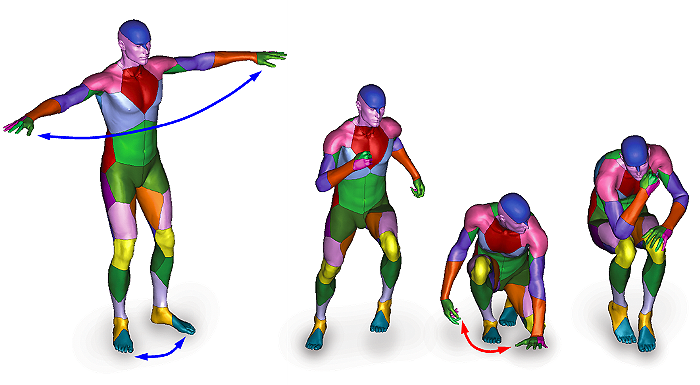|
Symmetry and structure analysis in deformable shapes

Examples of extrinsically (left) and intrinsically (right) symmetric objects.
Symmetry, referred to in some
contexts as self-similarity or invariance is the cornerstone of
Nature, exhibiting itself through the shapes of natural creations we see every day as well as through less evident yet omnipresent laws of physics. The interest in symmetries of shapes dates back to the dawn of the human civilization. Early evidences that our predecessors attributed importance to symmetries can be found
in many cultural heritages, ranging from monumental architecture
of the Egyptian pyramids to traditional ancient Greek
decorations. Johannes Kepler was among the first who attempted
to give a geometric formulation to symmetries in as early
as 1611. A few centuries later, the study of symmetric
shapes became a cornerstone of crystallography. Finally,
symmetries of more complicated higher-dimensional
objects underlie modern physics theories about the nature of
matter, space and time.
Since many natural objects are symmetric, the absence of symmetry can often
be an indication of some anomaly or abnormal behavior.
Therefore, detection of asymmetries is important in numerous
practical applications, including crystallography, medical
imaging, and face recognition, to mention a few. Conversely,
the assumption of underlying shape symmetry can
facilitate solutions to many problems in shape reconstruction
and analysis.
Traditionally, symmetries are described as
extrinsic geometric properties of the shape. While being adequate
for rigid shapes, such a description is inappropriate
for non-rigid ones: extrinsic symmetry can be broken as a
result of shape deformations, while its intrinsic symmetry is
preserved.
By considering shapes as metric spaces, symmetries can be described as self-isometries, i.e. automorphisms that preserve some metric defined on the shape. Using the Euclidean metric gives us traditional extrinsic symmetry. Using intrinsic, e.g. geodesic or diffusion metrics, allows to generalize the notion of symmetry to non-rigid shapes.
This construction readily extends to approximate or partial symmetries.
Generalized multidimensional scaling is used as a numerical framework for
intrinsic symmetry analysis, addressing the problems of full and partial exact
and approximate symmetry detection and classification.
Another interesting kind of self-similarity is regular repeating structure. Especially challenging is to detect intrinsic regularity, where the repetitions are on an intrinsic grid, without any apparent Euclidean pattern to describe the shape, but rising out of (near) isometric deformation of the underlying surface. Multidimensional scaling is used to reduce the problem of intrinsic structure detection to a simpler problem of 2D grid detection. We also present a range of applications including scan completion, shape editing, super-resolution, and structural correspondence.
Papers
N. Mitra, A. M. Bronstein, M. M. Bronstein,
"Intrinsic regularity detection in 3D geometry",
Proc. European Conference on Computer Vision (ECCV), 2010.
D. Raviv, A. M. Bronstein, M. M. Bronstein, R. Kimmel, G. Sapiro,
"Diffusion symmetries of non-rigid shapes",
Proc. Intl. Symposium on 3D Data Processing, Visualization and Transmission (3DPVT), 2010.
D. Raviv, A. M. Bronstein, M. M. Bronstein, R. Kimmel,
"Full and partial symmetries of non-rigid shapes", Intl. Journal of Computer Vision (IJCV), Vol. 89/1, pp. 18-39, August 2010.
D. Raviv, A. M. Bronstein, M. M. Bronstein, R. Kimmel, "Symmetries of non-rigid shapes", Proc. Workshop on Non-rigid Registration and Tracking through Learning (NRTL), 2007.
Data
Coming soon: Scanned plaster surfaces with repeating patterns
See also
Non-rigid shape similarity and correspondence
Partial similarity and correspondence
|
